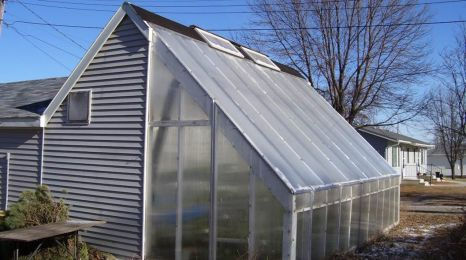Eat Fresh Vegetables Year-Round with a Deep Winter Greenhouse
- brookebowser

- Mar 14, 2020
- 3 min read
The frozen ground may be blanketed in a layer of fluffy snow with icicles clinging to the barn roof, but some families in Minnesota have been eating fresh greens for dinner all winter long.

A Deep Winter Greenhouse (DWG) is a greenhouse designed specifically for northern latitudes with cold, dark winters. These greenhouses limit the amount of energy required to grow crops during the winter months. DWGs are primarily passive energy greenhouses, which mean that they rely on energy from the sun to heat the building instead of traditional heating sources that often use fossil fuels.
There are different designs for DWGs, but all the designs share the important feature of being placed in an east-west position. The glazing wall, or the glass wall that allows the light into the greenhouse, faces south to provide exposure to the largest amount of sunlight. This south-facing wall is specially angled, according to the latitude, to get the most possible solar energy on even the coldest day of the year.
In the current design supported by the University of Minnesota Extension, the greenhouse is heated by the energy provided by the sun. The air inside is warmed and blown underground with a fan positioned in rocks below. The rocks act as a thermal mass and hold the heat that accumulates. You can think of them as a heat battery because they store heat for when it is needed at night. On especially cold nights, a back-up gas heater may kick in to help keep the temperature at 42 degrees.
These DWGs can be adapted to personal space and usage needs. Many can be built as a lean-to against a barn, which makes them more cost effective than a separate building. In her TEDxMinneapolis talk, Carol Ford, who constructed one of the first DWGs and inspired others to do so as well, explains that her greenhouse leans up against her garage. Her operational cost is about $100-200 per season, which runs from September to May. With further design upgrades, these DWGs have become even more efficient and financially feasible. It turns out that a cost-effective, passive-energy, and replicable DWG design is in popular demand in Minnesota. With these greenhouses, small-scale farmers and gardeners can produce crops that grow with minimal light. They have the opportunity to produce crops year-round. Lettuce, herbs, kale, broccoli, collarads, cabbage, and pea shoots are all various crops well-suited to DWGs.
In 2016, grant funding allowed the University of Minnesota Extension Regional Sustainable Development Partnerships (RSDP) to embark on a state-wide initiative to help support the construction of five of its latest DWG prototypes in regions across the state. The first DWG was completed and operational in February 2017. Partners receiving this support in this initiative agreed to provide access to their DWG for the University to collect research and further promote DWGs for three years.
A Deep Winter Producers Association has formed to help growers share ideas and methods to get the best production out of their greenhouses. They also host various events and greenhouse tours as educational activities.
“The thing that I like about this small design is that it can go where it’s needed, and in the food deserts there are so many opportunities for that,”said Crold Ford. From community gardens to retirement homes, to schools, places around the region can reap big benefits from these greenhouses.




Comments